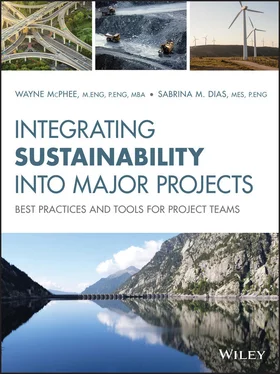17 CHAPTER 14: Closure 14.1 Closure Planning 14.2 Transition to Closure 14.3 Design for Closure 14.4 Progressive Reclamation 14.5 Summary
18 CHAPTER 15: Wrap-Up It's a New World for Delivering Major Projects So, What Can Project Teams Do? Managing Complexity What Does It Cost? Getting Started Sharing Your Stories Final Word
19 APPENDIX A: PESTLe Table of External Factors
20 APPENDIX B: Stakeholder Summary Template
21 APPENDIX C: Stakeholder Engagement Plan Sample Table of Contents
22 APPENDIX D: Stakeholder Communications Planning for Construction
23 Index
24 End User License Agreement
1 Chapter 2 Table 2.1 Time and space for players Involved in major projects.
2 Chapter 3 Table 3.1 UN Sustainable Development Goals. 1 Table 3.2 UN Global Compact Ten Principles. 2 Table 3.3 ISO standards applicable to integrating sustainability into a major pr...Table 3.4 Sample standards and guidelines management tracking table.
3 Chapter 4Table 4.1 Example of mapping PESTLe factors to generate insights and opportuniti...Table 4.2 Assessing activities with the sustainable activity model.Table 4.3a Sustainable activity model: sample list of project-focused activities...Table 4.3b Sustainable activity model: sample list of support activities.Table 4.4 Sample of sustainability topics and materiality ranking.
4 Chapter 5Table 5.1 Integrating sustainability into the project charter.Table 5.2 Sustainability policy topics.Table 5.3 Sample sustainability metrics.Table 5.4 Roles and sustainability responsibilities.
5 Chapter 6Table 6.1 Possible types of stakeholder groups.Table 6.2 Local community groups.
6 Chapter 7Table 7.1 Risk likelihood definitions.Table 7.2 Example of risk impact definitions.Table 7.3 Example of opportunity impact definitions.
7 Chapter 8Table 8.1 Sustainability integration framework sample deliverables.Table 8.2 Common management system elements.Table 8.3 Types of complaints for major projects.
8 Chapter 10Table 10.1 Integrated infrastructure strategies.Table 10.2 Advantages and disadvantages of locating on a brownfield site.Table 10.3 Sustainable options analysis.Table 10.4 Sustainable decision factors.Table 10.5 Lifecycle screening.
9 Chapter 12Table 12.1 Construction communication tools.Table 12.2 Environmental Management Plans
1 Chapter 1 Figure 1.1 Sustainability versus compliance. Adapted from Wheeler, Colbert, ... Figure 1.2 Sustainable project management model. Figure 1.3 Sustainability as a team sport.
2 Chapter 2 Figure 2.1 Sustainability strategies for different project structures. Figure 2.2 Traditional organization, government, and community relationship. Figure 2.3 Modern organization, government, and community relationship. Figure 2.4 Three pathways for successful project delivery.
3 Chapter 3 Figure 3.1 United Nations Sustainable Development Goals.
4 Chapter 4Figure 4.1 Three Circles of Sustainability.Figure 4.2 PESTLe Model.Figure 4.3 Sustainable Activity Model.Figure 4.4 GRI Materiality Principle.Figure 4.5 Sustainability Materiality Mapping.
5 Chapter 5Figure 5.1 Ability to influence project sustainability.Figure 5.2 Simple project organization chart.
6 Chapter 6Figure 6.1 Stakeholder mapping.
7 Chapter 7Figure 7.1 Risk register with current risks.Figure 7.2 Risk severity mapping.Figure 7.3 Risk register with planned risk management.Figure 7.4 Risk register with residual risk severity.Figure 7.5 Opportunity register.Figure 7.6 Opportunity mapping.
8 Chapter 8Figure 8.1 Simplified commitment action log.
9 Chapter 10Figure 10.1 Multi-criteria decision analysis example.
10 Chapter 14Figure 14.1 Sustainable life of a project.
1 Cover
2 Table of Contents
3 Begin Reading
1 iii
2 iv
3 ix
4 xi
5 1
6 2
7 3
8 4
9 5
10 6
11 7
12 8
13 9
14 10
15 11
16 12
17 13
18 14
19 15
20 16
21 17
22 18
23 19
24 20
25 21
26 22
27 23
28 24
29 25
30 26
31 27
32 28
33 29
34 31
35 32
36 33
37 34
38 35
39 36
40 37
41 38
42 39
43 40
44 41
45 42
46 43
47 44
48 45
49 46
50 47
51 48
52 49
53 51
54 52
55 53
56 54
57 55
58 56
59 57
60 58
61 59
62 60
63 61
64 62
65 63
66 64
67 65
68 66
69 67
70 68
71 69
72 71
73 72
74 73
75 74
76 75
77 76
78 77
79 78
80 79
81 80
82 81
83 82
84 83
85 84
86 85
87 86
88 87
89 88
90 89
91 90
92 91
93 92
94 93
95 94
96 95
97 96
98 97
99 98
100 99
101 100
102 101
103 102
104 103
105 104
106 105
107 106
108 107
109 108
110 109
111 110
112 111
113 112
114 113
115 114
116 115
117 116
118 117
119 118
120 119
121 120
122 121
123 122
124 123
125 125
126 126
127 127
128 128
129 129
130 130
131 131
132 132
133 133
134 134
135 135
136 136
137 137
138 138
139 139
140 140
141 141
142 142
143 143
144 144
145 145
146 146
147 147
148 148
149 149
150 151
151 152
152 153
153 154
154 155
155 156
156 157
157 158
158 159
159 160
160 161
161 162
162 163
163 164
164 165
165 166
166 167
167 168
168 169
169 170
170 171
171 172
172 173
173 175
174 176
175 177
176 178
177 179
178 180
179 181
180 182
181 183
182 184
183 185
184 186
185 187
186 188
187 189
188 190
189 191
190 192
191 193
192 195
193 196
194 197
195 198
196 199
197 200
198 201
199 202
200 203
201 204
202 205
203 206
204 207
205 208
206 209
207 210
208 211
209 212
210 213
211 214
212 215
213 216
214 217
215 218
216 219
217 221
218 222
219 223
220 224
221 225
222 226
223 227
224 228
225 229
226 230
227 231
228 232
229 233
230 234
231 235
232 236
233 237
234 238
235 239
236 241
237 242
238 243
239 244
240 245
241 247
242 248
243 249
244 250
245 251
246 252
247 253
248 254
249 255
250 256
251 257
INTEGRATING SUSTAINABILITY INTO MAJOR PROJECTS
Best Practices and Tools for Project Teams
Wayne McPhee, M.Eng., P.Eng., MBA
Sabrina M. Dias, MES, P.Eng.

This edition first published 2020
© 2020 John Wiley & Sons, Inc
All rights reserved. No part of this publication may be reproduced, stored in a retrieval system, or transmitted, in any form or by any means, electronic, mechanical, photocopying, recording or otherwise, except as permitted by law. Advice on how to obtain permission to reuse material from this title is available at http://www.wiley.com/go/permissions.
Читать дальше













